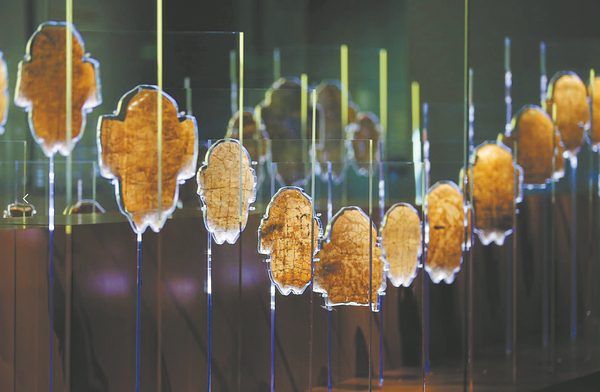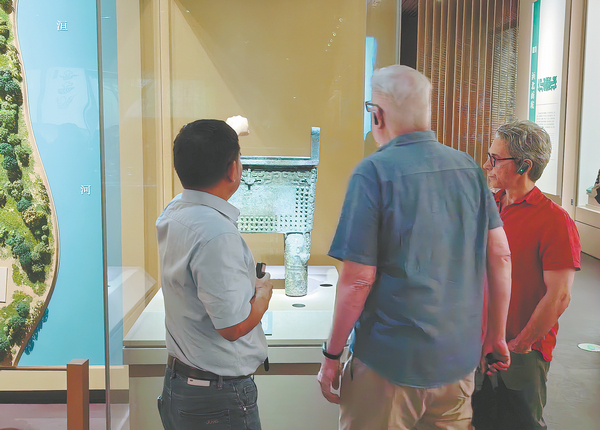Yinxu Museum Helps US Scholars Dig Deeper into Shang History
 |
| Oracle bone inscriptions displayed at the new hall of the Yinxu Museum in Anyang, Henan Province. [Xinhua] |
ZHENGZHOU — Nestled beside the tranquil Huanhe River in Anyang, Central China's Henan Province, stands the new hall of the Yinxu Museum, a striking structure in the shape of a bronze square ding, or ancient cauldron. Its exterior walls are adorned with classic Shang Dynasty (c. 16th century-11th century BC) bronze decorations, and the lintels above its three main doors feature the characters Da Yi Shang in bronze.
Anyang, the last capital of the Shang era, China's second dynasty, has been a focal point of archaeological significance since work began at the Yin Ruins in 1928. The site has yielded a wealth of exquisite bronzes, oracle bone inscriptions and other cultural relics that highlight Chinese civilization's enduring charm and grandeur.
"The characters Da Yi Shang mean the 'Great Settlement of Shang'. At that time, this was the most populous and prosperous city in China, and the Shang people proudly referred to it using this name," said Tang Jigen, one of China's most senior archaeologists on Shang, as he explained the meaning of Da Yi Shang, derived from oracle bone inscriptions, to three visiting American scholars on May 17.
The Director of the National Museum of Asian Art in the United States Chase Robinson, Deputy Director Lori Duggan Gold and Curator of Ancient Chinese Art J.Keith Wilson, traveled to this ancient city for inter-museum exchanges. In a single day, they explored the museum, visited the archaeological sites of Shang's largest palace ruins discovered so far and its royal tombs and held in-depth discussions with their Chinese counterparts. As the sun set, they found it difficult to leave, moved by the deep cultural connections they had forged.
America's National Museum of Asian Art in Washington consists of the Freer Gallery of Art and the Arthur M. Sackler Gallery and is part of the Smithsonian Institution, the largest museum complex in the world. The Freer Gallery of Art, founded in 1923 and the Smithsonian's first art museum, sponsored China's early works of the Yin Ruins archaeological excavation that began in 1928. In February 2023, to commemorate the centennial of the Freer Gallery, the National Museum of Asian Art held a special exhibition titled Anyang: China's Ancient City of Kings, which displayed over 200 artifacts from Shang. The exhibition continued until April 28.
"It was one of three major exhibitions that we mounted for our centennial. It's the only one that was up for 13 months. It occupied the main exhibition space in our museum and was very popular, not only with the public but also with critics and museum professionals," says Robinson, adding that it narrated a story of Shang civilization, technology, industry, city planning, archaeology and collaboration.
The exhibition's popularity in the US also inspired Chinese archaeology and cultural heritage scholars to bring the exhibition closer to Chinese audiences in Anyang by displaying several photos during the planning of the new hall of the Yinxu Museum.
The American scholars were delighted by the museum's design and the depth of their exchanges and mutual learning with their Chinese counterparts.
"Worldwide, we work together. It's very exciting for us to be featured here," says Gold. Her museum regards exchanges in arts as a big responsibility and takes very seriously how to share works and form partnerships and collaborations with the world.
"Seeing your exhibition was a stunning experience. Having more people see the Yin Ruins and sharing the discoveries with a broader audience is our shared mission," Zhao Qingrong, executive deputy director of the Yinxu Museum, told Gold.
"Over a century, the museum has been committed to understanding ancient Chinese civilization," says Robinson, expressing his wish to continue this tradition and carry out joint exhibitions, research projects and staff exchanges.
 |
| Chinese archaeologist Tang Jigen (left) introduces Simuxin Ding, an ancient bronze cauldron, to visiting curators from the National Museum of Asian Art in the United States, including Chase Robinson (right), director of the American museum. [Zhai Xiang/Xinhua] |
In 1977, Wilson visited China for the first time while attending college. Experiencing China's history and culture in person strengthened his determination to study it. Today, he has become a revered Sinologist in the US. He believes that Shang's most notable contribution to world civilization was the technology to produce bronzes, jades and ceramics of "incredible beauty and technical complexity".
Wilson refers to his visit to Anyang as "coming home". During his first visit to Anyang in the 1990s, he became good friends with Tang.
This visit showed not only friendship but also the power of international attraction of Anyang studies, Wilson says.
"The symbolism of having the Anyang exhibition at the time of our centennial was very rich," says Wilson, adding that the centennial was a moment to look forward and identify goals important for the next century.
Reflecting on his experiences since joining the National Museum of Asian Art in 2006, Wilson mentions that he has curated exhibitions on the Xiangtangshan Grottoes, Houma Bronzes and ancient Chinese music. He looks forward to continuing to introduce American audiences to important moments in Chinese history.
Digital products at the Yinxu Museum, such as 3D artifact short films and immersive digital exhibitions, left a deep impression on the American scholars.
"Many museums around the world hold artifacts from the Yin Ruins. We could bring together artifacts collected in different places in the form of a digital return of Yin Ruins artifacts," says Niu Shishan, a senior archaeologist of Shang's royal tombs.
Li Xiaoyang, director of the Anyang Municipal Bureau of Cultural Relics, proposed various collaborative efforts, such as exchanging information on cultural relics, sharing digital projects and coproducing documentaries.
In response, Robinson says that these proposals are attractive and research projects, collaborations and exchanges can be outlined through a memorandum of understanding. Archives concerning the archaeological projects of the Yin Ruins housed at Freer can also be made available.
Gold congratulates her Chinese counterparts on "the beauty of the building and the excellent interpretation for visitors to the gallery".
She adds, "I took many photographs today of how you designed the spaces to share with audiences."
Robinson says, "You have an extraordinary facility, an extraordinary collection and a wonderful story to tell."
As Robinson concluded his first visit to the Chinese mainland, he reflected on the importance of building trust and exploring possibilities together: "I'm very pleased that we've gotten such a good start.
"What impressed us most was the great expertise that's gone into the creation of this museum. There is also great expertise on the part of the archaeologists working on the site."
May 18 marked International Museum Day, with this year's theme being Museums for Education and Research. Robinson says America's National Museum of Asian Art owns the digital platform Teaching China, which is devoted to middle school students and teachers.
"It's been immensely successful. There is a real appetite from Americans to understand Chinese culture, history and Chinese civilization," he says.
"Expertise and knowledge are the foundation for great museums. It's the foundation for great archaeology, and you have a very strong foundation."
(Source: Xinhua)
Please understand that womenofchina.cn,a non-profit, information-communication website, cannot reach every writer before using articles and images. For copyright issues, please contact us by emailing: website@womenofchina.cn. The articles published and opinions expressed on this website represent the opinions of writers and are not necessarily shared by womenofchina.cn.








.jpg)

 WeChat
WeChat Weibo
Weibo 京公网安备 11010102004314号
京公网安备 11010102004314号